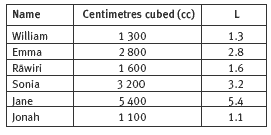This is a level 4 measurement strand activity from the Figure It Out series.
A PDF of the student activity is included.
Click on the image to enlarge it. Click again to close. Download PDF (219 KB)
convert between litres and cubic centimetres
modelling clay (optional)
FIO, Level 4, Measurement, Book One, Petrol Power, page 14
This page is about engine capacity and the relationship between the different units used to measure it. The activity reinforces the relationships emphasised on the two previous pages.
Students are asked to use modelling clay to accurately make a cube with sides of 1 centimetre or, as a less satisfactory alternative, to accurately draw a cube of this size. If modelling clay is not available, the cube could be made from carrot or potato. A simple way to draw a cube is to draw a square and then draw a second square to the right and up. Connect the vertices with straight lines:
After making or drawing the cube, the students are asked to compare its volume with a cube that has sides of 10 centimetres. The small and large cubes from base 10 place value blocks could be used for this purpose.
The students are then asked to order engines of various capacities and complete a table using both cubic centimetres and litres.
Investigation
This could be carried out in small groups, with the students finding out how an internal combustion engine works. They are asked to make scale models of cylinders of different sizes. These could be cardboard tubes. The students may need help with the mathematics here because they may not have yet met the volume of a cylinder (V= πr2h). When they have completed their investigation, they are likely to be surprised at how small the cylinders of a car engine actually are.
Cross-curricular links
Science
Achievement Objective
- investigate and offer explanations of how selected items of technology function and enhance everyday activities of people (Making Sense of the Physical World, level 4)
Answers to Activity
1. a. Practical activity. Here are three ways of drawing a cube:
b. 1 000 cm3. (10 x 10 x 10)
c. 1 L.
2. They are both the same. 1 800 cm3 (or 1 800 cc) is another way of saying 1 800 mL, which is the same as 1.8 L.
3. a. 1 300 cc, 1.5 L, 1.6 L, 2 000 cc, 3 000 cc, 3.2 L
b.
Investigation
Results will vary.



